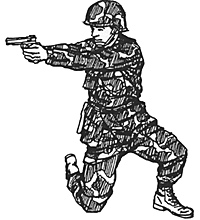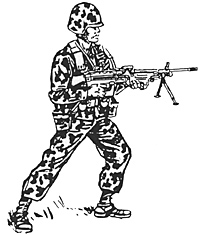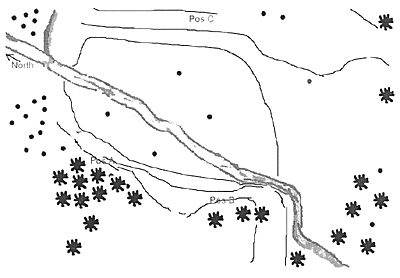 I am a member of the Swedish home guard. It occurred to me that last week’s exercise might be of interest to some of you. The object was how to position half-a-platoon to execute an ambush against a possibly armoured foe and get away alive. After “What happens” you may test your ambushing skills so don’t read that until ready for fighting.
I am a member of the Swedish home guard. It occurred to me that last week’s exercise might be of interest to some of you. The object was how to position half-a-platoon to execute an ambush against a possibly armoured foe and get away alive. After “What happens” you may test your ambushing skills so don’t read that until ready for fighting.
The situation
The big picture was with an invasion from a well-equipped enemy. Think American level of equipment with capable weapons systems of all kinds, IFV rather than APCs. (The Swedish home guard used to be the quickest force to respond and now with the standing army reduced to 4 brigades is more than likely the only force that will show up in response to any threat).
Last report was of a mechanised unit about 30 kilometres (18 miles) south of the ambush position, with no opposing Swedish forces between. Since there is at least one alternative road it is hard to guess if or in what force the enemy is moving up this road. There is still civilian traffic along the roads.
 The order
The order
The main object for the weaker force here is to delay the enemy advance north, for other units, further north to possibly halt it. The order for this half-platoon is to quickly prepare an ambush at a given position.
Equipment & personnel
The platoon leader has two squads of 8 men each and a dog-team. He has 8 AT-mines, 4 anti-personnel with manual fire (claymore type, called “Russian TV” here, anti-personnel mines are still allowed, providing they are fired manually). He also has one Karl-Gustaf bazooka and 8 onetime AT-rockets. Training status fair but old basic training.
Command and control
Contact with the company is intermittent and no other friendly units are nearby. Two radio sets are available for use.
Terrain
The chosen terrain is in wooded area. After a long straight 1km stretch, the paved road curves around a rock hill, first right then left down into a small open depression for about 150 meters. After that it climbs out of the depression. All elevated terrain is rocky hill, with some soil and trees but with stone visible (from my experience traversable with tracked vehicles, but with risk of de-tracking, due to the strain on the tracks).
 We examined three positions: A, B and C on the map. Map scale about 300 meters across. We decided on position A, because it offered good concealment, had a stone ridge just in front and was covered by trees. It too was narrow for two squads. Behind it there was a down slope and dense wood.
We examined three positions: A, B and C on the map. Map scale about 300 meters across. We decided on position A, because it offered good concealment, had a stone ridge just in front and was covered by trees. It too was narrow for two squads. Behind it there was a down slope and dense wood.
I liked position B because it covers all the area and from behind anyone traveling up the road and allowed for shooting from behind. It is narrow for two squads to group there and the back slope was open covered only by a tree line along the side of the road leading up to the ambush.
East of the road, the ridge is wooded behind position C and on the other side the hill, about 20 meters, follows a field after which the real wood commences. I was not too fond of that position, because the right flank was open to fire from a vehicle coming around the corner into the ambush site. It allows the squads to be deployed with standard frontage.
We did not find a use for the dog team, which is normally used static or on a patrol loop to detect strangers in the vicinity of the position. It is a non-fighting unit and could be used to check for possible enemy presence before deploying and at the reassembly point after withdrawing.
The terrain, Swedish wood, hilly, with the road.
Deploy
From this set-up of terrain it choose a deploy for the mines, fieldworks and the men, marking the position of bazooka, LAW and officers/radios.
What happens next?
Here are a number of cases to be considered:
- Civilian vehicles traveling north. Will they be able to just pass through? Will they run into the antitank mines or will you be able to stop them?
- Civilian vehicle with non-uniformed combatants lead an ordinary column. Followed within 10 minutes by a column of 20 vehicles of which 4 are soft skinned in the rear of the column, marching lead patrol of one vehicle, followed by main body. Halting on the straight stretch of road and dismounting. If the leading civilian vehicle detected your presence. If they were uncovered/dispatched quickly it so that your area presence but no position is known the enemy will dismount earlier and will be coming up the road with vehicles to cover the advance. Is there a pillar of smoke from the civilian car?
- You are detected by airdrone or other means. Attack from the air follows.
- The advancing enemy are aware that you are in position and, counting on weak capacity by you to respond, will deploy infantry to right and/or left of the road advancing to contact.
- Only a patrol of 1/2/3/4 vehicles is moving up the road, at good speed with 50-meter space between them. No sign of the rest of the unit.
- A company column comes up the road of 20 vehicles of which 4 are soft skinned in the rear of the column, marching lead patrol of one vehicle, followed by main body. Halting on the straight stretch of road and dismounting. If the leading civilian vehicle detected your presence. If they were uncovered/dispatched quickly it so that your area presence but no position is known the enemy will dismount earlier and will be coming up the road with vehicles to cover the advance. Is there a pillar of smoke from the civilian car?
- Upon arriving, the dog indicates that there are strangers in the area, which there shouldn’t be under these circumstances.
Extra variables:
Depending on the enemy’s evaluation of past experience and his opponent’s capability he could be marching in a tighter formation, meaning forsaking a lead patrol or shortening distance between vehicles.
He might try and drive through an ambush rather than smoke/fire/reverse, firing on the move.
Back to Table of Contents -- Lone Warrior # 143
Back to Lone Warrior List of Issues
Back to MagWeb Magazine List
© Copyright 2003 by Solo Wargamers Association.
This article appears in MagWeb.com (Magazine Web) on the Internet World Wide Web.
Other military history articles and gaming articles are available at http://www.magweb.com
